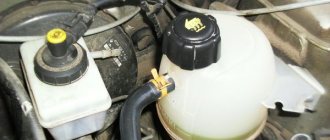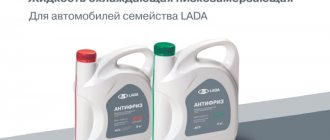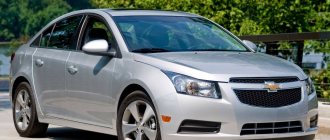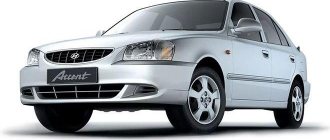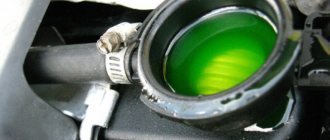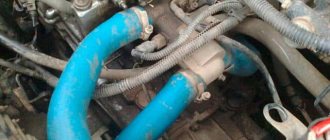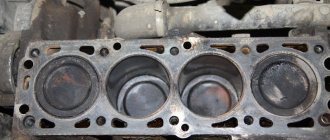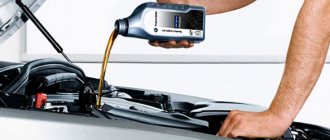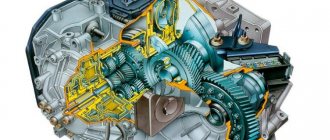01/26/2022 6,413 Consultation with a specialist
Author: Ivan Baranov
Hello. Is it possible to fill a Peugeot 308 with green antifreeze? (Elena)
Good day, Elena. We have always said and will continue to tell our users that the color of the coolant does not matter. Color does not in any way affect the composition and additives added to antifreeze. When purchasing this consumable, you should never be guided by color, since even the original coolant can be a fake with absolutely any shade.
[Hide]
Where is antifreeze drained on Matiz?
At the bottom of the radiator on the passenger side we find a pipe, place a container under it to collect the old coolant. We compress the clamp on the pipe and move it down, after which the hose can be removed (Fig. 2). To speed up the draining process, unscrew the cap on the filler neck of the expansion tank (Fig.
Interesting materials:
What formats can be used to store drawings with a palette of 256 colors? What phrases should you not say to Alice? Which fronts took part in the liberation of Belarus? What fruits and vegetables grow in June? What fruits and vegetables grow in Crimea? What functions does the pharynx perform? What functions does the state perform? What functions does the parasympathetic nervous system perform? What functions does Word perform? What functions do different types of RNA perform?
Opinions of car owners about antifreeze for Peugeot 408
- No less than G12 “How to select and fill in the appropriate lubricant? Permission must be taken into account. What antifreeze should I put in my Peugeot? Here it is worth paying attention to the class. However, it must be at least G12+.”
- Look at the tolerance
“Whether you are buying a lubricant or a coolant, always pay attention to the tolerance. It's simple. In general, in any incomprehensible situation, always check the approval, then you will not be mistaken with which refrigerant to fill.
Coolant
- Log in to reply to this topic
#21
- Users
- 24 messages
- No name
- City My city is not in the list
- The car is not Peugeot
#22
- Name Alexander
- Samara city
- Peugeot 308 car
#23
- Name Victor
- Rostov-on-Don
- Car Peugeot 207 5d
- More details Audi A6 (C7) 180 lc TFSI (white metallic) 2013
- Dreams of an Audi Q-5
#24
- City of Saint Petersburg
- Peugeot 308 car
#25
Let's live in such a way that even the undertaker mourns our death.
- Name Alexey
- City My city is not in the list
- Peugeot 308 car
- More details 120hp EP6 1.6V
- Dreams of a Peugeot Hoggar
Hello. Please tell me if anyone has encountered this issue. What kind of coolant does our 308 use? I looked and all my neighbors in the parking lot had either blue, or blue-green, or red. For some reason, mine is transparent yellow-orange with the smell of alcohol and non-oily. in our Nizhny Novgorod showroom they say that this is how it should be, that it comes from the factory like this. They sell something for around 350 rubles for 2 liters called “Peugeot coolant”, but they say that it is already blue-green in color (no need to dilute it), and that you can mix the factory version and the one on sale, Nothing will happen. The instruction manual only states that you should use the one recommended by the manufacturer. who gets out of the situation? What coolants does anyone use? Thank you!
#26
- Name istopnik
- City of Kirovsk (Murm.)
- Peugeot 308 car
- More details Peugeot 308 1.61 VTi 120hp with 5-speed manual transmission Release 2011
Citroen/Peugeot 9735.K0 Antifreeze "PSA Longlife", 5l (except 4007, C-Crosser,107) Citroen/Peugeot 9735.K1 Antifreeze "PSA Longlife", 2l Citroen/Peugeot 9735.K5 Antifreeze "PSA Longlife", 1l ( except 4007, C-Crosser,107)
my color is blue-green
Post edited by istopnikS: December 14, 2015 — 21:19
#27
- Name Lesha
- City My city is not in the list
- Peugeot 505 car
It’s even written in my manual to use G12 class antifreeze. It is light red in color. I am partly organic. I talked with the owners of 307, 3008 is recommended not to change. Pouring it. There is no difference in price. But the owner of 307, 3008, after using G10 (it’s green or blue), the rubber bands on the evaporator began to leak after a while. It's completely synthetic in my opinion.
And which side does the evaporator come into contact with antifreeze?
#28
More details about my car - https://www.drive2.ru/r/peugeot/1708432/
- Name Dmitry
- Kursk city
- Peugeot 407 car
- More details Peugeot 2.0Hdi RHR 2004
- Dreams of a BMW Alpine
I once wondered - I was looking for this PSA antifreeze, but in our muhosransk there is no such thing, it costs quite inhumane to order, like that, I spat and filled it with Felix G12. I probably skated 70-80 thousand on it, changed it once. In the summer, for unknown reasons, a plastic pipe flew out of the thermostat, and I stayed with my comrades at the agricultural base. they had the same yellow G12 Felix antifreeze. I changed it on the spot and left. Periodically disassembling the car, changing the thermostat, etc., I did not notice any scale, nor any sinks. The temperature is the same. On Lancer 9, once on the road there was a problem - I had to mix G11 and G12 - I didn’t notice any foaming, boiling, or deposits. HZ, maybe I was just lucky, or maybe it’s all just bullshit. I try to replace antifreeze every 30-40 thousand, or always after work such as changing the thermostat or radiator) Such are the things
Peugeot 308 Sport Back › Logbook › Original PSA Longlife antifreeze - drain immediately!
I don’t know what the PSA concern was guided by when it poured this gruel into brand new cars at the factory, but clearly not with the best intentions.
In this post I will tell you why I came to this conclusion.
photo of spikral from Goruks
. He also has good instructions for flushing the cooling system. Instructions for flushing the cooling system. Instructions for removing and washing the heater radiator. They will be useful to us later.
First a little theory
Currently, antifreezes (coolants) based on the composition of anti-corrosion additives are divided into lobrid, carboxylate, hybrid and traditional types. According to the Volkswagen classification, the division is as follows: G11, G12, G12+, G12++, G13
1) Traditional/antifreeze.
Base
: Ethylene glycol.
Additives
: based on silicates, borates, nitrides, phosphates and amines (at the same time).
Colour
: usually blue.
Action
: Covers the entire cooling system with a protective film of silicates.
Over time, the film grows quite large, which impairs heat transfer and reduces engine cooling efficiency. When heated to 108 degrees, additives may precipitate. Life span
is from 0.5 to 2 years.
If the liquid turns yellow after six months, this is a sure sign of corrosion. Compatible
with G11.
2) G11- Hybrid/or VW TL 774-D(G11), Traditional Coolant, Conventional Coolants, IAT (Inorganic Acid Technology)
.
Base
: Ethylene glycol.
Additives
: Contains inorganic silicate additives: silicates, phosphates, borates, nitrites, amines, nitrates.
Color
: Available in blue, green or blue-green.
Action
: similar to antifreeze.
The lifespan
has a slightly improved formula than antifreeze, so the lifespan of such antifreeze is up to 2 years.
Compatible
: with antifreeze.
3) G12 -Carboxylate/or VW TL 774-D(G12), Carboxilate Coolant, OAT (Organic Acid Technology)
.
Base
: Ethylene glycol.
Additives
: Based on organic carboxylic acids.
Color
: red.
Action
: The protective anti-corrosion film has a very small thickness and is formed only where there is a source of corrosion.
Life span
: up to 3-5 years.
Compatible
: with G12+/ G12++. Do not mix G11 and G12 under any circumstances.
4) G12+ - Carboxylate/or VW TL 774-F(G12+)? Hybride Coolant, HOAT (Hybride Organic Acid Technology)
(We combined carboxylate technology with silicate technology).
Base
: Ethylene glycol.
Additives
: Based on organic carboxylic acids and inorganic ones.
Color
: Purple.
Action
The operating principle is similar to G12.
Lifespan
: up to 5 years.
Compatible
with G12/G11/antifreeze.
5) G12++ - Carboxylate/or VW TL 774-G(G12++), VW TL 774-H(G12+++), Lobride Coolant, SOAT Coolants
.
Base
: Ethylene glycol.
Additives
: based on organic acids with a minimum amount of mineral additives using Lobrid technology.
Color
: Purple.
Operation
The operating principle is similar to G12/G12+.
Lifetime
: The boiling point is increased to 135°C, and at the same time all additives retain their properties.
Lifespan
: up to 5 years.
Compatible
with G12+/G12/G11/antifreeze.
6)Lobrid/G13.
.
Base
: unlike its predecessors, instead of a toxic ethylene glycol base, it has a harmless and “environmentally friendly” glycerin or propylene glycol base.
Color
: lilac.
Operation
The operating principle is similar to G12/G12+/G12++.
Lifespan
: up to 10 years.
Compatible
with G12+/G12/G11/antifreeze
To consolidate the theory, you can watch a very good video on YouTube Classification of antifreeze - - - - - - - - - - - - - - - - - - - - - - - - - - - - - - - - - - -
EDITED an hour after publication. Friends, thank you for putting me on the right path.
This link helped me with this, as well as this one and this one.
The original PSA Longlife antifreeze is a hybrid antifreeze i.e.
according to WV classification - G11. is a concentrate GLYSANTIN G33 from BASF
, diluted with distilled water and packaged in PSA Longlife canisters 9735 K0-5 liters, 9735 K1-2 liters, 9735 K5-1 liters. According to the WV classification, this antifreeze has a classification of G12. those. It's not as bad as I thought. )))
A well-known problem with the Peugeot 308 is a poorly heating stove.
Already in three-year-old cars, users note that the heater does not heat properly and from year to year it heats worse and worse. Those who have washed radiators note that the radiator honeycombs are very narrow. The reason lies in the principle of antifreeze action. Let me remind you: Antifreeze covers the entire cooling system with a protective film of silicates. Over time, the film grows quite large, which impairs heat transfer and reduces engine cooling efficiency.
All the same, the reason for the poorly heating stove, in my opinion, is precisely the timing of the antifreeze change. G12 lives under ideal conditions for up to 5 years. But as has been noted more than once, Russia is recognized as a country with difficult conditions. Therefore, it’s strange that the oil change schedule was reduced by 2 times (which is still not sufficient. Read more about choosing oil for EP6
in the previous entry), but the service life of the antifreeze was not reduced.
Moreover, PSA recommends a period for changing antifreeze - 6 years (or 120,000 km)!
Naturally, after this the stove will not heat up! By this time, it’s not even possible to determine the color of the expansion tank. Antifreeze had lost all its properties by this time, and for the last 3 years it not only did not protect, but contributed to corrosion processes. This is evidenced by the reddish tint of 5-6 year old antifreeze.
We can talk about the topic of what PSA people are bad people for quite a long time. but it won't change anything. And we need to think about our cars. What to do? Of course, change the antifreeze!
Taking this opportunity, you can upgrade to a higher class of antifreeze. I couldn’t find any information about G13, how good they really are. Usually, when they do something for the sake of the environment, they cut back on some useful properties. Therefore, I would focus on G12++ carboxylate antifreezes. In addition, their use will result in less scale formation. Let me remind you that G12++ has an increased boiling point to 135°C, and at the same time all additives retain their properties.
Before changing antifreeze
Be sure to flush the entire cooling system.
And not only with water, but also with chemistry (For example: Liqui Moly “Kuhlerreiniger”
). If the shift deadlines are not met, the additives are likely to precipitate. The reason for the need to use chemicals lies not only in the fact that it is necessary to wash off the scale that has formed in the cooling system, but is also related to the principle of operation of hybrid antifreezes. G11 covers the entire cooling system with a protective film and now needs to be removed to unlock the full potential of more modern antifreeze. In addition, manufacturers do not recommend mixing antifreeze of different brands, guided by the fact that it is not known how the additives will react to each other. Although in the conditions for using antifreeze they write that they can be mixed, but with the caveat “only in emergency cases.” Then it is recommended to change this batch at the first opportunity. It is also worth adding the fact that when different classes of antifreeze are mixed, the service life of this mixture is equal to the service life of the lowest class antifreeze.
From the history of the cooling mixture
Antifreeze began to be widely used on cars in the 60-70s in Europe and America. At first these were simple solutions of ethylene glycol and glycerin in water. But soon special coolants (coolants) appeared, focusing on use in certain types and specializations of cars: cars and trucks, for the tropics and northern regions. Divisions by brand appeared, first among manufacturers of engines for trucks, agricultural and construction equipment, and then in the passenger car industry due to specialization - minicars, middle class, executive and sports cars. In the 60s, automakers began to require the use of special, proprietary standards for fuel, lubricants and cooling materials in their vehicles.
In the USSR, they first became acquainted with industrial antifreezes during the Great Patriotic War. Foreign coolant was supplied to our country to service Lend-Lease equipment. Antifreeze liquids were used on Soviet cars before the war, but their production was mainly handicraft, and was done in garages and at MTS. There was no need for anything else, because until the early 50s, Soviet people did not have the right or opportunity to own a car as a personal property, so retail sales of automobile fuels and lubricants did not exist.
Filling a UralZIS-355M truck with antifreeze on the conveyor belt of the Ural Automobile Plant
Based on Lend-Lease, Soviet industry began to produce its own cooling mixtures in accordance with GOST 159-52. All this appeared on the shelves only in the 60s, but car enthusiasts more often had to mix the ingredients themselves, preparing antifreeze in their yards or kitchens.
The “breakthrough” was the emergence of the Volzhsky Automobile Plant, built by FIAT. In fact, the Italians completely reformed the automotive life of the USSR. After all, in addition to the car assembly plant in Togliatti, an entire industry of auto components was built with hundreds of enterprises in all corners of the vast country, where licensed or “solid-drawn” products were produced, which quickly migrated from VAZs to other Soviet passenger cars and trucks.
The appearance of VAZ also affected antifreeze. Until the early 70s, Paraflu 11 antifreeze from FIAT Sezione Lubrificante was supplied to the Soviet Union from Italy for servicing Zhiguli cars. Based on this coolant, the USSR developed a similar product of its own production, called “TOSOL” (“organic synthesis technology” and the ending “-ol”, used in specialized literature to designate alcohols). They completely replaced foreign fluid, ceasing to purchase it abroad, accepted it for initial filling at all car factories in the country, and made it standard - the cooling systems of all new domestic cars had to be designed for TOSOL.
It is curious that until 1989, TOSOL was produced according to industry specifications, and only in 1989 GOST 28084-89 appeared, which determined the standards of packaging, transportation and requirements for “foaming”, but did not in any way regulate the composition of the product and its quality. For this reason, legends about a certain “high quality” of Soviet antifreeze are nothing more than fiction and a beautiful legend.
This “legend” quickly collapsed and was forgotten as soon as in the 90s a flood of new and used foreign cars poured into Russia, for which the use of TOSOL was like death due to the primitiveness of its characteristics and disgusting quality, which even in Soviet times “limped on both legs."
Unfortunately, the flow of not new, but tens of times more advanced than our own, foreign machines was almost not supported in any way and was accompanied by technical information about their design, routine maintenance, the level of technology used and the quality of materials. Even the “Kulibins” and “Lomonosovs”, who took up the task of servicing complex equipment, could not save the catastrophically low level of technical training of motorists - the consequences of this total auto illiteracy are still evident today.
In relation to antifreeze, technical ignorance is reflected in monstrous conjectures, inventions and myths, which are skillfully used by traders, hucksters and counterfeit manufacturers.
As a result, the sellers of bullshit “liquids” and fakes are “in chocolate”, and car enthusiasts, having parted with a certain amount of money for a low-quality coolant or one not intended for their car, are left “with nothing”, or rather, with “dead” cooling systems with prospects expensive repairs due to ignorance of simple truths, being led by various would-be advisers and trusting scammers. Surprisingly, even many respected authoritative automotive media are guilty of amateurism and incompetence in relation to antifreezes and their choice, as if indulging in dishonest swindlers.
Choosing the wrong antifreeze for a car and mixing the right one with the wrong one can have catastrophic consequences for the engine cooling system (in the photo - radiator channels clogged with coagulated coolant)
We will now correct all this by talking about:
- What fairy tales and fictions about liquids for cooling systems should you beware of and under no circumstances take into account before purchasing;
- What antifreeze to choose for a car and what to follow when choosing it for Peugeot, Citroen, DS, Dongfeng and many other cars.
Antifreeze - what kind?
Please forgive me: there are a lot of articles on the Internet, but that’s the question.
During the last repair it was discovered that the amount of antifreeze had decreased. It was assumed that it evaporated through a crack found in the expansion tank plug. Well, no problem, I ordered a new one, 214 rubles. - a small amount for peace of mind.
But before this time the antifreeze was changed. Antifreeze was poured green. And they said, of course, that it was also green. Left over from last year's replacement at another service - I think I'll give it a share. But it turned out that the yellow one remained o_O
There are a lot of opinions on the Internet:
1) “The original antifreeze poured into the Peugeot 308 has a blue-green color and a G11 approval
, produces PSA Longlife under its own label. But in fact, this is the usual GLYSANTIN G33, which is produced by BASF. PSA Longlife markings for antifreeze are 9735.K1, 9735.K0, and for concentrate 9735.K4.
According to the manufacturer's recommendation, the fluid must be replaced after 6 years or 120,000 km. But as experience shows, the factory fluid must be changed after 2 years of operation. Based on the experience of motorists who own this brand, it is advisable to do a complete wash when replacing. Do not use original antifreeze, but buy G12 or a higher class
and go to it."
2) I have a Peugeot 308; 2008; 1.6l; 120hp gasoline, now I need to buy antifreeze, I know what’s red
colors, but I don’t know what brand/article of this product, therefore I ask for help in this matter.
Color no difference
.
unless of course it is a complete replacement. grade G-12
. any manufacturer.
Previously, the original was Glisantin G33 and Revkogel 2000. G12 - G12 are different. I use TOTAL GLACELF AUTO SUPRA (concentrate, pink-orange), TOTAL COOLELF AUTO SUPRA (ready-made). The service department said that this is a complete analogue of the original (the original had exactly the same color).
And so, the signs recommend G12++ as a replacement for oil-club.
And, yes, I’ll quote the forum: “The problem is that each company considers it necessary to add its own substance. VW, BMW - silicates, KIA / Hyundai - phosphates, PSA - molybdates... (etc., etc.). so what you meant by “any” is not clear. If you follow the principle of all oils/antifreezes from one barrel, then yes, use any.”
“...according to PSA, molybdates included in their antifreezes are necessary to achieve their standards for corrosion, pump cavitation, etc. and so on.".
3) It’s already been discussed on Drive, and there’s generally a wild pluralism of opinions here: www.drive2.ru/l/5732653/
So which one should I pour? What does color affect? Is it bad if you mix different colors?
PS On the wise advice of Dulfer308, I picked up the receipts and grabbed my head: last year I was filled with Lukoil G12, this year there’s something called GreenCool G11
Source
What antifreeze is better to fill in Peugeot 308 (1.6 petrol)
Don't know what antifreeze to put in your Peugeot? In this case, you need to study the vehicle's operating instructions. There you will find recommendations from the car manufacturer regarding the coolant and lubricant that can be used. By the way, the green-colored refrigerant may be antifreeze, and it can only be filled in if nothing else is at hand.
What antifreeze is recommended for the Peugeot 308? Choose G12 standard coolant. This classification is used by most refrigerant companies and is only given if the antifreeze is suitable for your Peugeot model. The shade of G12 liquid can be different: reddish, green, yellow and even blue. However, you should not think that any refrigerant of the listed shades will necessarily meet that standard.
It is best to purchase the original coolant, which is called “PRO”. It can be poured into Peugeot, as well as Citroen. However, such antifreeze is not available in every car shop.
When choosing a refrigerant, you should talk to a consultant who will present you with all the coolants related to G12. It is also necessary to carefully study the label; it will contain all the necessary data.
If you don’t know what antifreeze to fill in your Peugeot 308, check out the opinions of other car owners. The following brands have proven themselves best:
In addition, when choosing what antifreeze to fill in your Peugeot, you should take into account what budget you have, as well as your coolant requirements. To fill the cooling system in a Peugeot, you will need at least 6.2 liters of refrigerant. Do not forget that you need to not only replace the antifreeze, but also flush the system, radiator, and also the engine.
To find out what kind of antifreeze can be poured into the Peugeot 306 (year of manufacture 1993–2001), study the following table:
Engine
Color
Lifetime
Recommended Manufacturers
Glysantin G 48, Lukoil Extra, Aral Extra, Mobil Extra, Zerex G, EVOX Extra, GenantinSuper
Lukoil Extra, Zerex G, Castrol NF, AWM, GlycoShell, Genantin Super
Glysantin G 48, Havoline AFC, Nalcool NF 48, Zerex G
Mobil Extra, Aral Extra, Nalcool NF 48, Lukoil Extra, Castrol NF, GlycoShell
AWM, EVOX Extra, GlycoShell, Mobil Extra
Havoline AFC, Aral Extra, Mobil Extra, Castrol NF, AWM
Aral Extra, Genantin Super, G-Energy NF
GlasElf, AWM, MOTUL Ultra, G-Energy, Freecor
Castrol SF, G-Energy, Freecor, Lukoil Ultra, GlasElf
For example, if you have a first-generation Peugeot 306 manufactured in 1993, whose engine runs on diesel fuel or gasoline, which antifreeze is best to fill in? In this case, you need to use hybrid refrigerant G11, shade green. The fluid should be changed every 3 years.
We recommend
When purchasing, you should check whether the coolant meets the requirements of the car manufacturer, and whether it is suitable for the maintenance interval.
What antifreeze to fill in Peugeot: color, brands, manufacturers
Issues discussed in the material:
The color of the coolant does not always matter, but then what kind of antifreeze should you put in your Peugeot? The question is really important, because for each brand of car you need to choose exactly its own option so as not to spoil the operation of the engine.
Also, when purchasing, you should keep in mind that even original coolant can easily turn out to be a fake, being of absolutely any shade. We will tell you further about what type of antifreeze to choose and what to take into account.
Leaks and problems
The main reasons associated with antifreeze leakage lie in ignorance of certain details. In the Peugeot 308, such a small thing is the coolant reservoir cap. It has two valves, inlet and outlet, to maintain an optimal system pressure of 1.4 bar.
To avoid jamming, the valves must be periodically washed, and the plug itself must be changed every 2 years. When the valve jams, the pressure in the system increases and, as a result, antifreeze leaks in a weaker place.
Leaks in the Peugeot 308 cooling system, if they do occur, in most cases are not difficult to determine the location. As usual, this could be leaky pipes or a water pump, from which the leak will be noticeable on the timing belt guard.
Liquid may also leak from the thermostat, but this problem may not be immediately detected, since this place is covered by the installed air filter housing.
Replacing antifreeze: after how long and when to change it
If a Peugeot, Citroen or Opel car is new and manufactured at the PCMA plant in Kaluga, based on the operating experience of many owners, we recommend completely changing the factory coolant at the first maintenance (10,000 km on the odometer or 1 year of operation) in full, replacing it with a high-quality, foreign-made, PSA B71 5110 approved one.
The reason for this “unpatriotism” is that too many owners of Kaluga-made cars complain on social networks about too rapid loss of performance, premature degradation of the properties of antifreeze filled at the factory.
Dongfeng cars have a similar effect of early coolant depletion, so the recommendation of a full-volume replacement of antifreeze at the first maintenance is also relevant for models of this brand supplied to Russia.
European-made PSA Peugeot Citroen cars have never had problems with the quality of antifreeze supplied to the conveyor. Therefore, for them and the above-mentioned cars, we recommend changing the coolant at intervals of 60,000 km or 3 years of operation, depending on which parameter comes first.
Get ready for the fact that in service books, warranty instructions or operating manuals you can read something fantastic, like: “replacement of coolant is not provided for during the entire service life of the vehicle.” The evil chimera of this phrase is that the term “service life” is actually commensurate with the warranty period, and not the duration of the entire life of the car until it falls apart, as most Russian car enthusiasts are accustomed to understanding. This is another argument in favor of changing antifreeze every 60,000 km or 3 years.
Remember that the coolant is supplied in the form of a concentrate or a ready-made diluted liquid, and if you use a concentrate to replace or top up, then it can only be diluted with purified distilled and demineralized water!
